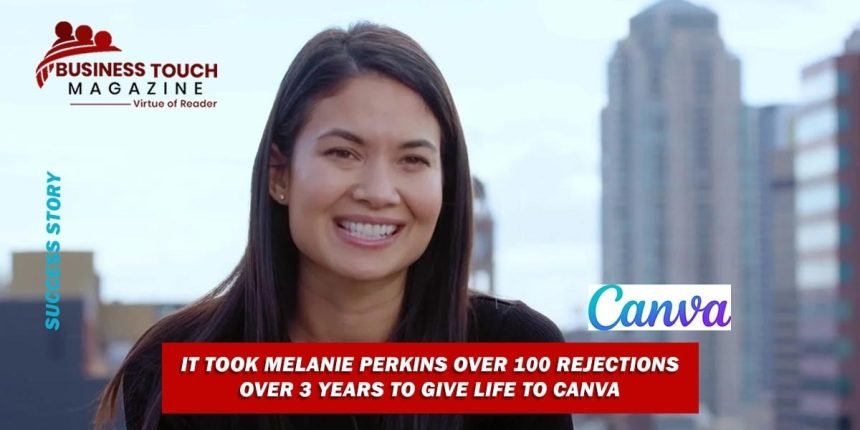Melanie Perkins, who is just in her 30s, has accomplished a lot for someone her age. Currently serving as the chief executive officer of Canva, the world’s largest design community, she is the third wealthiest woman in Australia. Perkins is one of the world’s most inspiring young business executives because of her tenacity and resolve, which led to her enormous success and propelled Canva to the top of the business world.
Childhood
Melanie Perkins entered this world in 1988 in Perth, Western Australia. Her mother is an Australian native, while her father is a Malaysian of Filipino and Sri Lankan origin. Both of her parents are educators and professionals; her dad is an engineer. Perkins showed early signs of an entrepreneurial mindset. At the age of 14, she started her own company selling scarves she had created at various markets in Perth. She dreamed of making a living as a skater and would get up at 4:30 every morning to practise. She spent most of her formative years at Sacred Heart College before transferring to the University of Western Australia.
Education Perkins earned degrees in communications, psychology, and business from the University of Western Australia. As a part of her degree, she also instructed pupils in the fundamentals of computer graphics. When she saw how much her pupils were struggling with Adobe Photoshop and other advanced design programs, she was motivated to create a simpler, more effective alternative. After two years of education, Perkins decided to focus on his business career instead.
Early Career
During 2007, Perkins and her then-future husband Cliff Obrecht created Fusion Books. Fusion Books is an online resource that provides students with a drag-and-drop tool and a library of design templates, such as images, artwork, and typefaces, to create their own school yearbooks. Fusion Books was a huge success despite the fact that she had to abandon her original plan to focus on a different one due to a lack of funding.
Perkins started working on Fusion Books in her mom’s house, and both of her parents were involved in the venture’s early stages, printing the yearbooks. In the meanwhile, Obrecht would make cold calls to institutions in an effort to bring in new business. Over the course of only a few short years, Fusion Books grew to become the dominant Australian yearbook publisher, with subsequent international expansion into France and New Zealand.
Canva Co-founder and CEO
Fusion Books had been doing well, but money was becoming tight. Consequently, both Perkins and Obrecht sought funding from venture financiers, who first supported Fusion Books but went on to back the firm that would become Canva Inc. Perkins said she approached over a hundred potential investors in Perth, but was turned down each time.
In 2011, when renowned entrepreneur and investor Bill Tai was in Perth to serve as a judge for a startup competition, an opportunity presented itself. Canva was pitched by Perkins and Obrecht during a dinner thrown by Tai, but they were unsuccessful in raising capital. Tai instead often invited them to future kite-surfing parties, which also happened to be gatherings for IT investors. Both Perkins and Obrecht were often required to fly across the nation to attend these events, with many of them taking place in Silicon Valley. Even in Silicon Valley, many companies were unconvinced by Perkins’ presentation. It wasn’t until a former Google executive joined the team that things started to change. As a result of recruiting Cameron Adams, who had the necessary technical skills, the team was given a significant boost, and Perkins was finally able to get the finance he had been seeking for years.
The business began operations in 2013 after two rounds of startup investment. Canva appointed Perkins as CEO, Obrecht as COO, and Adams as Chief Product Officer. In less than a year after its inception, the firm had signed up 600,000 users. After finding success in other countries, Canva opened up shops in Beijing and Manila. Canva China’s largest client is McDonald’s. In the years that followed, Canva received further investment and added features to the app, such as the “Canva for Education” learning collaboration tool.
The rise of Canva has also shone a focus on CEO Melanie Perkins. Despite Canva’s still-limited presence in the US market, she is a beloved figure in the IT industry’s hottest hotspot. She was recognized as one of Forbes’ Top Under 30 of the Decade and 2016’s 30 Under 30. Canva’s staff is 41% women, far more than the industry average of 28%, and she is a champion of a more diverse and inclusive workplace. In June 2020, Canva raised $60 million, increasing its value to $6 billion and making its founder, Perkins, the third-wealthiest woman in Australia with a net worth of $1.3 billion. After mining mogul Gina Rinehart ($16.25 billion), TPG co-founder Vicky Teoh is the third-wealthiest person in the world. Perkins has no plans to release Canva to the public anytime soon, despite the company’s healthy financials.
Perkins’s lifelong ambition to create a visual design platform accessible to anyone with no design experience has been achieved by the phenomenal success of her company, Canva. Canva’s drag-and-drop interface is similar to that of Fusion Books, allowing users to quickly and easily create a wide variety of designs, such as social media graphics, presentations, posters, papers, and more. Canva has become a popular substitute for Adobe’s industry-standard Photoshop and Illustrator. Canva has 30 million active users in 190 countries, putting it close behind Adobe in terms of market share. This is one of the few firms that has already turned a profit ($1.86 million net profit on $25.1 million in sales in the first half of 2017). With a monthly or yearly ($119.40) subscription, customers get access to all 40,000 Canva templates since the firm uses a freemium revenue strategy.
For this reason, “we’ve made it free to use,” as Perkins puts it, “we want Canva to be the destination you can go to by default.” The “stories we hear from the community is what makes all the labor worth it,” she has said, referring to the good comments her firm has received from its consumers. Obrecht echoed these comments, saying that the Canva platform may greatly help “underprivileged individuals and provides them the possibility to escape the cycle.”
Personal Life
Melanie Perkins, CEO of Canva, recently weds long-time lover Cliff Obrecht. Two companies, Fusion Books and Canva, were started by the pair. In 2019, while vacationing in Cappadocia, Turkey, Obrecht presented Perkins with a $30 engagement ring and asked her to be his wife. The pair has often said that the vast majority of their wealth is donated to various causes. Since being invited to frequent kite-surfing meetings by Bill Tai, Perkins has developed a passion for both travelling and the sport of kite-surfing.
No matter how far Melanie Perkins takes Canva in the future, the fact that the company’s creator overcame many obstacles to reach where she is now should not be forgotten. Everyone agrees that at the tender age of 32, she is only getting started in her career.




